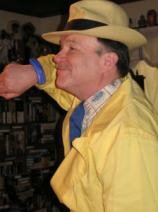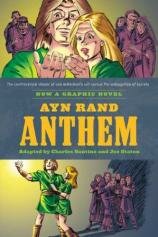American Anthem: Charles Santino
Writer Charles Santino has been working on comics for decades, and when he saw an opportunity to adapt Ayn Rand’s book Anthem to the graphic-novel format, he rang up artist Joe Staton, and the pair got to work. With two longtime comics pros working on such a famous book, the result is an interesting, compelling read. We talked to Santino about adapting the book.
You’ve been in comics for a while. What are some of your previous credits readers will know you from?
I wrote the Dell/Abyss psychological horror novel Toplin with Michael McDowell; I wrote Conan the Barbarian for Marvel Comics, and I adapted, scripted, and packaged Aesop’s Fables for Fantagraphics.
How did you get involved with Anthem?
There’s some chatter on the internet that the Ayn Rand Institute (ARI) initiated the graphic novel adaptation. That’s incorrect. The project originated with my production studio, Marshall Holt Entertainment. I approached ARI with a treatment and they referred me to NAL (Penguin).
When did you first read Anthem, and how did it affect you when you did?
My first treatment is dated May 18, 2007, so I must have read the book shortly before that. I reacted to my first reading of Anthem on a number of levels simultaneously. My first reaction was, why aren’t Brave New World by Aldous Huxley, 1984 by George Orwell, and Anthem by Ayn Rand mentioned together, as they logically should be? They are all literary works dealing with the threat of totalitarianism. All are set in the future. They were all written within two decades of each other in the first half of the 20th century, and they are all by world-famous authors. They’ve all sold millions of copies.
Another reaction was the immediate feeling that Anthem was perfectly suited to the graphic-novel format. I was confident of this, even before I broke it down into scenes to see exactly how it would play out and what major issues I would confront in translating the novella to a visual format. I also thought: How is it possible that someone has not done this before? I quickly made sure that it hadn’t been done. When I established that there was no graphic novel of Anthem, I knew I had to work quickly to create a treatment and get it in front of a publisher.
Then there’s the story itself, which I thought was beautiful, clever, and moving. Although it seemed completely original in concept, I later found out that Rand was probably influenced by reading “By the Waters of Babylon” by Stephen Vincent Benét, which was published as “The Place of the Gods” in The Saturday Evening Post, and the Russian novel We by Yevgeny Zamyatin. The Benét story is also set in a post-apocalyptic, technologically devolved future as is Anthem, but his short story is almost devoid of any profound ideas. We shares some of the concepts ofAnthem, but it is set in a high-tech future. So it seems that Rand cross-bred the two works and plugged her own philosophy into it as well.
The most daring aspect of Anthem is the unorthodox structure of the story. On one level, it’s a romantic adventure about the forbidden love of the narrator, Equality 7-2521, and his girlfriend, Liberty 5-3000, but a little more than halfway through this very short work—55 pages into the edition I first read—the “action” is over, and the narrator’s intellectual and emotional journey really begins.
Are you a fan of Ayn Rand’s? Why or why not?
Neither a fan nor a detractor. Anthem is the only book I’ve read by Rand, but I was of course aware of her longer novels. Beyond that, I think that “fandom” implies an uncritical devotion to something, which can be a trap. Many of the writers, filmmakers, painters, and musicians who have created art that I enjoy have also produced some really awful work.
Without giving anything away, the very last word of the novel is also the very last word in your graphic novel, showing how faithful you were to the original book. Was it difficult to translate the book entirely to the graphic format?
Yes. I toyed briefly with the idea of including the entire opening section, almost 10 percent of the novella, but if I kept it, that section would have looked and read like a textbook. This “backstory” section works fine as prose, but I think it would have been boring as drawn panels and captions. The passages toward the end of the story that are almost pure philosophy with no narration or action—and yet are important to the impact of the story—had to be treated graphically, so I had to act the role of a magazine art director, concocting images to illustrate abstract ideas. I think I discarded more visual concepts here before I was satisfied than any other section of the book. My habit of sketching out the whole graphic novel in rudimentary thumbnail drawings—a technique that might be unique for a writer who is not also an artist—is incalculably helpful in determining how to craft each page. It’s hard for me to imagine how writers of comic books and graphic novels write a script without sketching, which to me would be like a carpenter sawing a board without measuring and hoping it fits.
In terms of pure words, I probably used about a third of the words of the novella. I didn’t lose anything that I wish I could have kept, but making the decisions as to what was necessary and what had to go was a demanding process.
Given our volatile political status right now, not just with the Democratic and Republican parties but also with the rise of the Tea Party movement, Ayn Rand is as controversial as ever. How do you see her work fitting in with the political landscape today?
I inadvertently caught a wave of popularity for Rand in the timing of the publication of the graphic novel of Anthem. I have read that her sales have doubled or tripled in the last few years. In Anthem, and apparently in her longer novels, Rand presents fictionalized treatments of many ideas from the political right and even some from the political left and although she’s certainly not the only one to have done so, she might be the most prominent. It’s interesting to me that she is popular with some people on the right, because the stereotype of the right is that they are Bible-thumpers, but my understanding is that she was an atheist and that her works, both fiction and nonfiction, paint a very unsympathetic portrait of religion. So maybe certain people are picking and choosing their ideas “cafeteria-style,” which is probably healthy.
How did you and Joe Staton first meet and get involved on working together on this?
I first contacted Joe in 1993 and we’ve worked on a number of projects that never saw the light of day. When I signed the contract to package Anthem, I told the publisher that I wanted Joe to draw it and I showed them a few pieces of his, including a comic book cover that had just about every DC character on it, and a sample of his art for the Femme Noir webcomic. The publisher asked for some concept art for Anthem and with a little tweaking to that art, I had the go-ahead to hire Joe. I hired Zach Matheny and Glass House Graphics for the lettering and digital production. The publisher composed the front and back matter, gave me that, and I gave them back a 144-page digital file that was ready for the printer.
The theme of Anthem is all about the power of the individual and how it should not be overrun by the power of society as a whole. How does the book speak to you personally and how do you interpret its message?
I think the story does a wonderful job of making the case that a totalitarian society denies basic human rights.
Do you plan to do any other Ayn Rand works in graphic novel form? If so, will you work with Joe on them?
If Anthem does well, I will likely have the option of making further proposals to the publisher involving Rand properties. Whether I do so will depend not only on the sales of Anthem, but whether another Rand adaptation makes sense at that time for Marshall Holt Entertainment. If Joe seems like the right artist for that hypothetical project, I’ll try to get him involved.
What are you working on next?
I’m finishing up the script for the adaptation of an adventure story by a popular author. There will be a webcomic going up sometime this year, which is about a private investigator in a science-fiction setting. Neither are far enough along for details. Beyond that, there are a few other projects in development that need more work.









